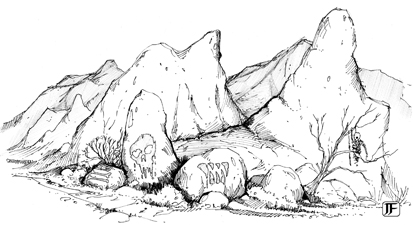The Savage Coast

- Area Square Miles: See Below

 The rough area in square miles of that nation.
The rough area in square miles of that nation. - Population: See Below

 The total population, including all significant humanoid races, plus the average population per square mile.
The total population, including all significant humanoid races, plus the average population per square mile. - Racial Balance: See Below

 The details of all the major races of that country, as a percentage of the total population.
The details of all the major races of that country, as a percentage of the total population. - Capital City: None (see below)

 The capital city of that country, if it has one, along with its population.
The capital city of that country, if it has one, along with its population. - Government: See Below

 The political structure for that nation, if any. This will be one of: autocracy, confederation, democracy, despotism, dictatorship, imperial, monarchy, oligarchy, republic or tribal. By far, the most common form of government is monarchy.
The political structure for that nation, if any. This will be one of: autocracy, confederation, democracy, despotism, dictatorship, imperial, monarchy, oligarchy, republic or tribal. By far, the most common form of government is monarchy. - World View: None (see below)

 The attitude of each nation toward its neighbors (passive, defensive or aggressive) and a number of terms that best sum that nation up (ie agricultural, nomadic, seafaring, wild, etc). Each nation can have one or more such terms, but will only ever have one attitude.
The attitude of each nation toward its neighbors (passive, defensive or aggressive) and a number of terms that best sum that nation up (ie agricultural, nomadic, seafaring, wild, etc). Each nation can have one or more such terms, but will only ever have one attitude. - Religion: Fandor, Gorazyn, Nendagon, Omuz, Pith, Uther

 The main gods esteemed by that nation. The list reflects the racial balance statistics (see above); so if humans are the largest racial group in that nation, followed by elves and dwarves, the list of deities follwed by humans will be first, then elves and dwarves. Within this context, they are listed alphabetically. No deity is listed more than once, even if more than one racial group prays to that god (for instance, both elves and gnomes are likely to follow Ky, but it will only be listed once nonetheless).
The main gods esteemed by that nation. The list reflects the racial balance statistics (see above); so if humans are the largest racial group in that nation, followed by elves and dwarves, the list of deities follwed by humans will be first, then elves and dwarves. Within this context, they are listed alphabetically. No deity is listed more than once, even if more than one racial group prays to that god (for instance, both elves and gnomes are likely to follow Ky, but it will only be listed once nonetheless). - Languages: Noroven

 The main languages spoken by the people of that nation, listed alphabetically.
The main languages spoken by the people of that nation, listed alphabetically. - Climate: Arctic

 The climate of that nation, from: arctic, continental cool summer, humid subtropical, subarctic, subtropical, temperate, tropical, warm temperate.
The climate of that nation, from: arctic, continental cool summer, humid subtropical, subarctic, subtropical, temperate, tropical, warm temperate.
Overview
The Savage Coast has become home to a large number of small settlements that have established themselves on the harsh northern coastlines. As well as the freezing temperatures, disease and starvation that is common to these communities, the indigenous inhabitants are hostile and humanoid activity high.
The settlements have no particular ties with one another, though local communities will often aid another if they are able, and the political structure of each community is entirely dependant upon the makeup of its inhabitants. Politics tends towards that which helps them survive, so law and order are essential ingredients. None of the settlements are particularly large, but are numerous and spread across the coastal regions.
The settlements are heavily reliant upon the trade with the northern nations of Arrasia, who supply them with essential products that are in short supply, especially grains and other foodstuffs, plus raw materials required to augment their own fledgling industries. Without any real wealth, ivory, pelts and furs are often traded in return. Life within the settlements is harsh and all too often brief, with arctic goblins making regular attacks, especially during the winter months. Frost giants are also a problem and are greatly feared.
Significant Trade Export
Ivory: Walrus ivory is used to trade for necessary goods to survive. Often the ivory is exquisitely carved and sells throughout Arrasia for a high price.
Pelts and Furs: The harsh climate means that the furs and pelts originating from this region are highly desirable. Being readily available, these represent the settlements' lifeblood, which they use to trade for important and life saving supplies.
Brief History
The first people to attempt to colonize The Savage Coast were the Norvs who had been uprooted from Norvsond under the harsh regime of King Ould the Unforgiving. Very few of these early settlements lasted long, falling to starvation, disease and the frenzied attacks of the local denizens.
Despite these early failures, the people of the north have continued their attempts at colonization, though still with limited success. The people who live here now are hardy and exist in a tough environment, often isolated from the rest of Arrasia, on whom the colonists rely so heavily.
The hard life has allowed little in the way of political evolution, with the settlements self-reliant and only limited mutual assistance between geographically local settlements in times of need. The future for these hardy folk is uncertain, but so it always has been. However, the rumors of great wealth and the lure for land is enough to keep the colonists coming.

